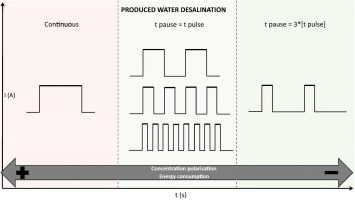当前位置:
X-MOL 学术
›
Desalination
›
论文详情
Our official English website, www.x-mol.net, welcomes your feedback! (Note: you will need to create a separate account there.)
Improving the performance of polymer-flooding produced water electrodialysis through the application of pulsed electric field
Desalination ( IF 9.9 ) Pub Date : 2020-06-01 , DOI: 10.1016/j.desal.2020.114424 P.A. Sosa-Fernandez , J.W. Post , M.S. Ramdlan , F.A.M. Leermakers , H. Bruning , H.H.M. Rijnaarts
Desalination ( IF 9.9 ) Pub Date : 2020-06-01 , DOI: 10.1016/j.desal.2020.114424 P.A. Sosa-Fernandez , J.W. Post , M.S. Ramdlan , F.A.M. Leermakers , H. Bruning , H.H.M. Rijnaarts

|
Abstract Concentration polarization and fouling hamper the desalination of polymer-flooding produced water (PFPW) via electrodialysis (ED). This water is an abundant by-product from the oil and gas industry. A common technique to mitigate both problems is the application of pulsed electric field (PEF), which consists in supplying a constant current during a short time (pulse) followed by a time without current (pause). Accordingly, this work evaluated the application of PEF during the ED of PFPW to improve the process performance and to reduce fouling incidences. The experimental work consisted in performing ED batch runs in a laboratory-scale stack containing commercial ion exchange membranes. Synthetic PFPW was desalinated under different operating regimes until a fixed number of charges were passed. After each experiment, a membrane pair was recovered from the stack and analyzed through diverse techniques. The application of PEF improved the ED performance in terms of demineralization percentage and energy consumption, the latter having reductions of 36% compared to the continuous mode. In general, the shorter the pulses, the higher the demineralization rate and the lower the energy consumption. Regarding the application of different pause lengths, longer pauses yielded lower energy consumptions, but also lower demineralization. Amorphous precipitates composed of polymer and calcium fouled most on the anion and cation exchange membranes, independently of the applied current regime, but in a moderate amount. Finally, the present study relates the observed effects of PEF application to the electrophoresis and diffusion of HPAM, and shows that PEF is a sound option to enhance the desalination of PFPW.
中文翻译:

应用脉冲电场提高聚合物驱采出水电渗析性能
摘要 浓度极化和结垢阻碍了聚合物驱采出水 (PFPW) 通过电渗析 (ED) 的脱盐。这种水是石油和天然气工业的丰富副产品。缓解这两个问题的常用技术是应用脉冲电场 (PEF),它包括在短时间(脉冲)内提供恒定电流,然后是无电流时间(暂停)。因此,这项工作评估了在 PFPW ED 期间 PEF 的应用,以提高工艺性能并减少结垢发生率。实验工作包括在包含商业离子交换膜的实验室规模堆栈中执行 ED 批次运行。合成 PFPW 在不同的操作制度下脱盐,直到通过固定数量的充电。每次实验后,从堆栈中回收了一对膜,并通过多种技术进行了分析。PEF 的应用在脱矿率和能耗方面提高了 ED 性能,与连续模式相比,后者降低了 36%。一般来说,脉冲越短,脱矿率越高,能耗越低。关于不同暂停长度的应用,较长的暂停产生较低的能量消耗,但也较低的脱矿质。由聚合物和钙组成的无定形沉淀物在阴离子和阳离子交换膜上污染最多,与施加的电流状态无关,但数量适中。最后,本研究将观察到的 PEF 应用对 HPAM 的电泳和扩散的影响联系起来,
更新日期:2020-06-01
中文翻译:

应用脉冲电场提高聚合物驱采出水电渗析性能
摘要 浓度极化和结垢阻碍了聚合物驱采出水 (PFPW) 通过电渗析 (ED) 的脱盐。这种水是石油和天然气工业的丰富副产品。缓解这两个问题的常用技术是应用脉冲电场 (PEF),它包括在短时间(脉冲)内提供恒定电流,然后是无电流时间(暂停)。因此,这项工作评估了在 PFPW ED 期间 PEF 的应用,以提高工艺性能并减少结垢发生率。实验工作包括在包含商业离子交换膜的实验室规模堆栈中执行 ED 批次运行。合成 PFPW 在不同的操作制度下脱盐,直到通过固定数量的充电。每次实验后,从堆栈中回收了一对膜,并通过多种技术进行了分析。PEF 的应用在脱矿率和能耗方面提高了 ED 性能,与连续模式相比,后者降低了 36%。一般来说,脉冲越短,脱矿率越高,能耗越低。关于不同暂停长度的应用,较长的暂停产生较低的能量消耗,但也较低的脱矿质。由聚合物和钙组成的无定形沉淀物在阴离子和阳离子交换膜上污染最多,与施加的电流状态无关,但数量适中。最后,本研究将观察到的 PEF 应用对 HPAM 的电泳和扩散的影响联系起来,



























 京公网安备 11010802027423号
京公网安备 11010802027423号